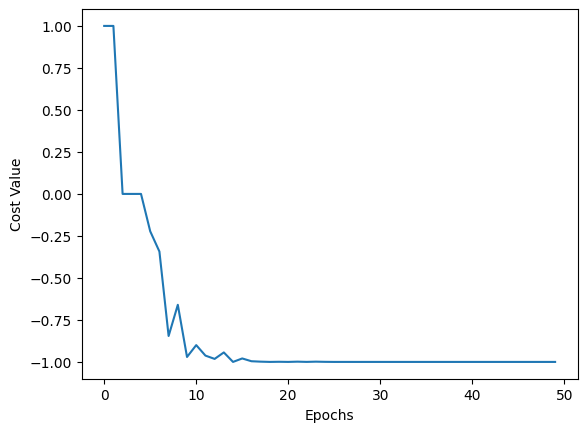Single Qubit Rotation¶
Below we start with a basic example of a hybrid variational algorithm which involves flipping the bloch vector of a qubit from the \(\ket{0}\) to the \(\ket{1}\) state. First we import the relevant packages and set our backend to simulate our workflow on NVIDIA GPUs.
[5]:
import cudaq
from cudaq import spin
cudaq.set_target("nvidia")
[2]:
qubit_count = 1
# Initialize a kernel/ ansatz and variational parameters.
kernel, parameters = cudaq.make_kernel(list)
# Allocate qubits that are initialised to the |0> state.
qubits = kernel.qalloc(qubit_count)
# Define gates and the qubits they act upon.
kernel.rx(parameters[0], qubits[0])
kernel.ry(parameters[1], qubits[0])
# Our hamiltonian will be the Z expectation value of our qubit.
hamiltonian = spin.z(0)
# Initial gate parameters which intialize the qubit in the zero state
initial_parameters = [0, 0]
We build our cost function such that its minimal value corresponds to the qubit being in the \(\ket{1}\) state. The observe call below allows us to simulate our statevector \(\ket{\psi}\), and calculate \(\bra{\psi}Z\ket{\psi}\).
[15]:
cost_values = []
cost_values.append(initial_cost_value)
def cost(parameters):
"""Returns the expectation value as our cost."""
expectation_value = cudaq.observe(kernel, hamiltonian,
parameters).expectation_z()
cost_values.append(expectation_value)
return expectation_value
[6]:
# We see that the initial value of our cost function is one, demonstrating that our qubit is in the zero state
initial_cost_value = cost(initial_parameters)
print(initial_cost_value)
1.0
Below we use our built-in optimization suite to minimize the cost function. We will be using the gradient free COBYLA alogrithm.
[ ]:
# Define a CUDA Quantum optimizer.
optimizer = cudaq.optimizers.COBYLA()
optimizer.initial_parameters = initial_parameters
result = optimizer.optimize(dimensions=2, function=cost)
[19]:
# Plotting how the value of the cost function decreases during the minimization procedure.
# !pip install matplotlib
import matplotlib.pyplot as plt
x_values = list(range(len(cost_values)))
y_values = cost_values
plt.plot(x_values, y_values)
plt.xlabel("Epochs")
plt.ylabel("Cost Value")
[19]:
Text(0, 0.5, 'Cost Value')

We see that the final value or our cost function, \(\bra{\psi}Z\ket{\psi} = -1\) demonstrating that the qubit is in the \(\ket{1}\) state.